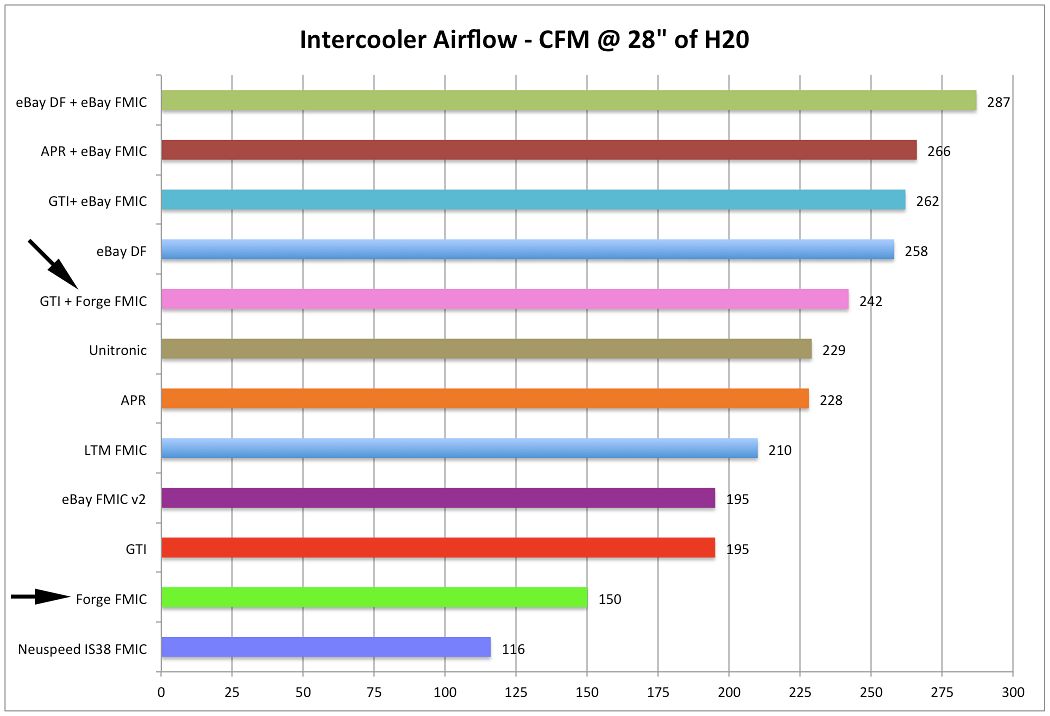Continued testing of the Forge products has moved on to a Forge Motorsport Bicooler Intercooler.

The Forge intercooler is supplied with a hose set that only allows for use as a bicooler, but for the flow tests the intercooler is going to be measured first with the Forge core only, and then along with the stock GTI intercooler.

The Forge core produced an airflow of 150 CFM @ 28″ of H2O.
Next the bicooler is flow tested in conjunction with the Mk7 GTI stock location intercooler.

Flow reading of the dual core setup is 242 CFM @ 28″ of H2O.
The results from these flow tests are shown on the chart along with other intercoolers:

Note: This test is only of flow performance, this test does not correlate with cooling performance.

It is interesting how these flow tests are shaking out.
The volume does appear to make a difference, but only to a point.
The Forge FMIC (total core dimensions 416.875 c.i) is smaller than the ebay v2 FMIC (667.275 c.i), approx. 63% size. Yet the flow is closer to 77% when measured alone.
When paired with the GTI FMIC the flow is 92%.
The extra volume does appear to improve the flow rate, but the return is clearly on a sliding scale.
This is made even more apparent as the addition of the APR intercooler to the ebay v2 FMIC netted only a 4 CFM increase over the ebay v2 and stock GTI combo, despite the extra 33 CFM and 384 c.i. of the the APR unit (493 c.i. vs 877.5 c.i.).
I wonder at what point the increases in size and flow become negligible?
I do realize that the flow readings and core sizes do not equate directly. For example the APR IC is over 100 c.i. larger than the Unitronic, yet the flow rates are essentially the same. Still, these measurements are a good indication of what kind of results one is likely to see from these units.
Again, your efforts are greatly appreciated. I can’t imagine the hours you have spent on these tests as well as compiling all the data, which is clearly presented and does not appear biased in any way.
I don’t consider the volume based on core exterior dimensions when looking at airflow trends. The channels that the air travels through don’t correlate with that volume. I look at the number of charge rows and the core depth as a better indicator, but that still is a poor way to try and estimate airflow since the interior channel turbulator structure will significantly affect the airflow.
In some of these cases I think there may be factors like the bicooler hoses that are coming into play or the end tank inlet and outlet piping or the end tank designs.
It should get interesting once I can establish a repeatable process for comparing cooling efficiency and then match that with the airflow results.
Thanks for the feedback, I’m glad you’ve found the information helpful.
Is the silicone hose where it bends to go into the Forge IC a smaller diameter on purpose or is it pinched?
That appeared to be how the hoses were made. It’s like that on both sides and mounting the bicooler so the weight was pulling down on the hose did not change the shape.
Do you find that a curious design choice? DECREASING diameters seems contradictory to maximizing airflow, no?
It may be a result of the packing. They put the hoses in a narrow box and use expanding foam to hold everything in place. It looks like the hose may return to a more round shape once installed for a while. For now though it’s not springing back to a circular cross section at that corner.